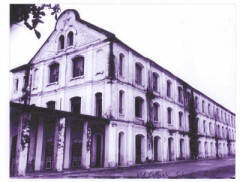
Je cadeautjes zeker op tijd in huis hebben voor de feestdagen? Kom langs in onze winkels en vind het perfecte geschenk!
- Afhalen na 1 uur in een winkel met voorraad
- Gratis thuislevering in België vanaf € 30
- Ruim aanbod met 7 miljoen producten
Je cadeautjes zeker op tijd in huis hebben voor de feestdagen? Kom langs in onze winkels en vind het perfecte geschenk!
- Afhalen na 1 uur in een winkel met voorraad
- Gratis thuislevering in België vanaf € 30
- Ruim aanbod met 7 miljoen producten
Zoeken
Omschrijving
Photographer Bill Burke has taken annual trips to Indochina ever since he first traveled to Asia in 1982. Although he usually photographed the people, Burke became aware of how the architecture absorbed as much as reflected the region's history. Transfixed by buildings like the municipal offices built by the French in the 1860s, the vaulted railroad stations and post offices of the 1930s, and the art deco fantasy cinemas of the 1960s, Burke saw the region as an architectural museum, rotting in the humidity and untouched by economic ambition, and began to trace the cultural changes in the area through its architecture. In Autrefois, Maison Privee-the title means "once a private house," and refers to the prevalent reappropriation of once private houses for municipal and government use-Burke captures the dramatic history of the area, from the influence of French colonialism through the rise of communism and the devastating effects of the Vietnam War, to the repopulation of Cambodia after the fall of Pol Pot and the Khmer Rouge and the opening of the area to capitalism. Burke's first entree into Indochina occurred during the period of Soviet control, a period of recovery that allowed for the current explosion of capitalism, which has already begun to devastate an architectural heritage that was well preserved in the deep freeze of socialism. What the B-52s and tanks didn't destroy during decades of war, developers from neighboring countries are busily replacing and defacing with their shrines of commerce. Autrefois, Maison Privee is the only book to delineate this transformation; featuring Burke's signature gritty layout and design, Autrefois, Maison Privee is a marvel livre deluxe of history, architecture, and photography.
Specificaties
Betrokkenen
- Auteur(s):
- Uitgeverij:
Inhoud
- Aantal bladzijden:
- 184
- Taal:
- Engels
Eigenschappen
- Productcode (EAN):
- 9781576871805
- Verschijningsdatum:
- 1/06/2004
- Uitvoering:
- Hardcover
- Formaat:
- Genaaid
- Afmetingen:
- 342 mm x 255 mm
- Gewicht:
- 1923 g

Alleen bij Standaard Boekhandel
+ 208 punten op je klantenkaart van Standaard Boekhandel
Beoordelingen
We publiceren alleen reviews die voldoen aan de voorwaarden voor reviews. Bekijk onze voorwaarden voor reviews.









